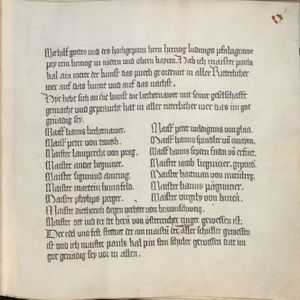|
|
You are not currently logged in. Are you accessing the unsecure (http) portal? Click here to switch to the secure portal. |
The Tradition of Johannes Liechtenauer
 |
Caution: Scribes at Work This article is in the process of updates, expansion, or major restructuring. Please forgive any broken features or formatting errors while these changes are underway. To help avoid edit conflicts, please do not edit this page while this message is displayed. Stay tuned for the announcement of the revised content! This article was last edited by Michael Chidester (talk| contribs) at 20:27, 28 August 2017 (UTC). (Update) |
Contents
A note on common fencing
This article
Johannes Liechtenauer, the High Master
- And before all things, you shall note and know that there is just one art of the sword, and it may have been discovered and conceived many hundred years ago, and it is the foundation and core of the entire art of fencing. Master Liechtenauer internalized and applied it quite completely and correctly—not that he discovered and conceived it himself, but rather, he traveled through many lands and sought the legitimate and truthful art for the sake of experiencing and knowing it. (Ms. 3227a)
Little is known about the life of Johannes Liechtenauer. We don't know when or where he lived, or what his family or martial lineage was. He would not even be mentioned by his first name until the creation of the Starhemberg Fechtbuch (Cod.44.A.8) in 1452; prior to that, he is named only as "Master Liechtenawer". His surname signifies that he (or his family) originated in a place called Liechtenau, but there are many towns of that name across Central and Eastern Europe. His name also offers another biographical clue: he is universally called Johannes Liechtenauer, not Johannes von Liechtenau, a decidedly middle-class name for the originator of a knightly art.[1]
The only other biographical note that we have is the quotation given above, indicating that he traveled through many lands seeking knowledge of the art of fencing, and ultimately became a master swordsman. Between craftsmen putting in their years as journeymen, mercenary companies moving from one hot spot to another, armed caravans of merchants moving goods over vast distances, and religious pilgrims seeking out far-flung holy sites, travel in this period was not uncommon and opportunities abounded for young men who wished to learn exotic fighting arts.[2]
The Fellowship of Liechtenauer
- Here begins the art that Liechtenauer, may God have mercy on him, has created with his fellowship and applied with all knightly weapons. (Cgm 1507)
In 1470, another master named Paulus Kal authored a lavishly illustrated fencing manual, and began it by listing sixteen masters who formed a group called the Fellowship of Liechtenauer.
The Recital of the Art of Fencing
- Because the art belongs to princes and lords, knights and squires, and they should know and learn this art, he has written of this art in obscure and cryptic words, so that not everyone will grasp and understand it, and he has done this on account of frivolous fight masters who mistake the art as trivial, so that such masters will not make his art common or open with people who do not hold the art in respect as is its due. (Cod. 44.A.8)
Teaching from the the Recital
- And so Master Sigmund ain Ringeck, at the time known as fencing master to the highborn prince and noble Lord Albrecht, Count Palatine of the Rhine and Duke of Bavaria, had these same obscure and cryptic words of the Recital glossed and interpreted, so that any one fencer who can already fight properly may well go through and understand. (Ms. dresd. C.487)
Liechtenauer's students
Other glossators
Expanding into other weapon forms
- Wrestle well, grappler.
Lance, sword, and messer
Manfully handle,
And in others’ hands ruin. (Jud Lew)
Modifying the art for new generations
Reviving the art in the 20th century
- ↑ The convention of reserving "von" for nobility was widespread but not universal, of course, which is why this is merely a clue rather than a fact.
- ↑ Similar claims are made by other masters in this period, including Fiore de'i Liberi, Martin Syber, and Joachim Meyer.

